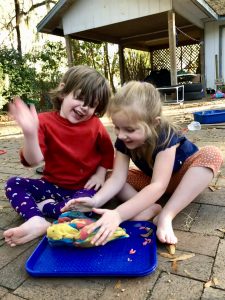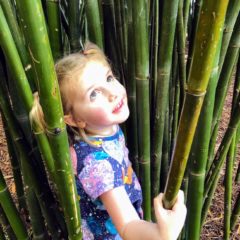Manipulation, Mastery and Meaning – identifiable and predictable stages of the learning process
I learned about these stages, sometimes referred to as ‘the 3-M’s of self discovery’ while studying education in college, and they are such an accurate way to describe child behavior that they immediately became part of my regular vocabulary. To my knowledge these stages were originally named and described by Janice Beaty in Preschool: Appropriate Practices (1991) but I’ve seen them referred to in a variety of other websites and books.
So here’s what I’m talking about:
As children learn and discover various aspects of their world, they generally progress through three stages. Sometimes they work their way through all three, other times they stop after stage one or stage two.
Manipulation
This is the initial exploration and discovery stage. The ‘mess with it’ stage. When presented with new materials or even intangible things like ideas, children will be driven to explore every piece of what is available immediately, moving quickly from one thing to the next. Children in this stage just want to touch absolutely everything. It is pure investigation. Understanding this stage immediately changed how I present a new activity or new play materials to Cat or any children I happen to be working with. Unless there’s a significant reason to do otherwise, I simply hand them the materials and say “What can you do with these things?” I will communicate any important rules and safety warnings, but otherwise let them loose. If there is a clear purpose for the materials, they will generally figure it out without my help. Sometimes they surprise me, and come up with far more interesting and engaging activities than I could have imagined. Rather than providing instruction or direction, I simply make observations of what I see them doing, and answer any questions that arise. Children in this stage can make a truly impressive mess.
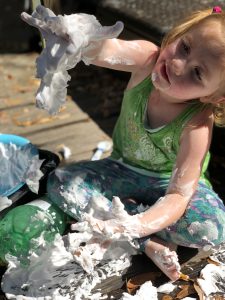
Mastery
This is probably the stage that gets the most attention because it’s so easily identifiable. And it can be extremely annoying. This is the ‘over and over again’ stage. The child who wants to read the same book 8 billion times in a row when there are 50 others on the shelf. The child who draws exactly the same picture or scribble in the same way over and over again. The child who wants to play the same simple game in exactly the same way until you’ve gone completely crazy.

Now, I am very glad to have learned about mastery in school because learning about it has served to *somewhat* reduce my irritation when I encounter it. What I learned is this: Mastery is literally the brain building itself. We want kids to learn and develop, and that’s a process of neurons forming connections in their brains. When kids get stuck on these ‘over and over again’ loops, that’s what’s happening. I’ve heard it referred to as ‘self-imposed practice’, and that idea makes a lot of sense to me. Just as playing scales over and over helps a pianist develop their skill, doing the same thing over and over again in all sorts of areas of life helps a child learn to live. I’ve also learned the immense value to providing an acceptable outlet for the mastery work that kids need to do. Children have a strong need to perform activities like pouring, dumping, emptying and filling in this over and over again sort of way. Given access to materials like water and sand, they are more likely to leave my pantry alone.
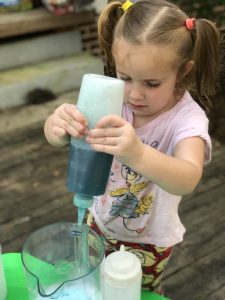
I pay close attention to my own emotional reactions to things, and I have noticed that my irritation at mastery behaviors is usually associated with a belief somewhere in my brain that engaging in lots of different activities is superior for Cat’s development. “If we go down this slide 50 times, she’ll miss the rest of the playground!” As I have learned to truly accept that going down the slide 50 times is truly the best thing for her, it has allowed me to relax and join her in her joy. It is such intense joy. While mastery play is at times frustrating and tedious for me, for children it is anything but. It is engaging, exciting, and deeply fulfilling.
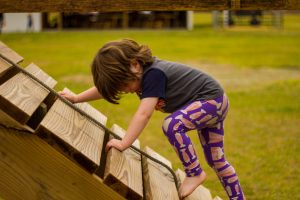
The mastery process is incredibly important to a child’s development, and in school they taught us exactly one way to respond to it: Let it happen. Read your child the book 8 billion times. Play the game as many times as your sanity will allow. Unless there’s a compelling reason to intervene, such as a threat to the child’s safety, work to ensure that their practice can continue until it comes to its natural close. This is not a time to enforce turn taking or sharing, even in a classroom setting. So, for the most part, that’s how I respond when I see this mastery behavior. Eventually, this stage will end on its own (really!). If mastery is driving me crazy, I find it useful to assume that there’s a certain, set number of times my child needs to do this thing in this way. May as well get it over with now. Mastery behavior leads to the next stage – sometimes the transition is obvious, other times the child simply files away their new skill into their toolbox for when they need it.
Meaning
The last stage is meaning. The child takes the skills they have learned through the previous stages and put them to work in some meaningful way. Sounds become words which they put together to express thoughts and eventually tell a story. Eternal scribbling makes way for drawing pictures and words. Simple block towers become houses, cities, whole worlds. Creativity abounds. The meaning stage is, for me, by far the most fun. Joining my child in her creative imaginative exploration and play helps me reconnect to my own inner artist, creator and dreamer.
